“Anyone? Anyone?” – What Ferris Bueller’s Economics Class Got Right About 2025
 Ahoy there, Trader! ⚓️
Ahoy there, Trader! ⚓️
It’s Phil…
Imagine if Ferris Bueller’s teacher, the one droning on about the 1930s tariff act, had access to TradingView, zero-day SPX options, and a mildly unhealthy obsession with pulse bars.
“In 1930, the United States government passed the… anyone?… Smoot-Hawley Tariff Act… anyone?”
Except now, in 2025, instead of a dusty overhead projector, we’ve got global supply chains imploding on live feeds, China slapping 84% retaliatory tariffs on pork and semiconductors, and stock tickers having existential crises in real time.
Welcome to the most dramatic remake of a Depression-era trade war since… well, the actual Depression.
And guess what? You’re trading right in the middle of it.
But here’s the good news:
In 1930, traders had no idea how to protect themselves.
In 2025, you’ve got SPX credit spreads, mechanical setups, and pulse bar logic that cuts through political tantrums like a katana through a soggy trade agreement.
So let’s dig in.
I’ll show you:
-
Why this isn’t your grandad’s tariff war (but eerily close)
-
What’s getting smashed in the SPX right now
-
And how to trade smarter than the policymakers driving this dumpster fire
Also, yes – we’re going to quote Ferris Bueller again, because he somehow nailed macroeconomic policy better than half of Twitter Finance.
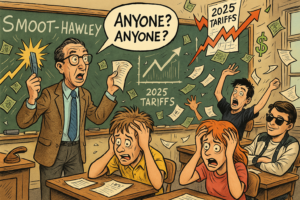
Tariff Chaos Then vs. Now: A Chain Reaction Breakdown
Smoot-Hawley walked so “Liberation Day” could rage-tweet its way into a global recession.
Cause #1: Political Bravado Disguised as Economic Strategy
-
1930: U.S. politicians slapped tariffs on 20,000+ products thinking they were helping farmers.
Result: Retaliation from 25 countries. Exports fell. Depression deepened. Oops. -
2025: “Reciprocal” tariffs were introduced by the truckload. 10% on everything. 20–50% on countries that dared to sell to America.
Result: China responds with 84% tariffs. EU queues up $23B in retaliation. Twitter implodes.
Lesson: History called. It said, “You didn’t learn a thing, did you?”
Effect #2: Retaliation Becomes a Global Sport
-
Smoot-Hawley Era: Canada started the trend. Then Cuba, France, and the whole gang joined in.
-
Today:
-
China: 84% tariffs. Bonus round: antitrust probes into U.S. tech.
-
EU: €21B in countermeasures.
-
Brazil: Tariffs on ethanol.
-
India: Tariffs on almonds (because of course).
-
UK: Polite disapproval and some very stern eyebrow raises.
-
Markets tank. Diplomats scramble. Soybeans cry.
Fallout #3: SPX Sector Wipeouts
-
Tech? Slapped. Supply chains crushed. Nvidia and Apple caught in the crossfire.
-
Autos? Hit from both ends. Tariffs on parts + declining exports = an expensive lesson in vertical integration.
-
Retail? Walmart just added “Tariff Pricing Strategist” to the job board.
-
Agriculture? Dead cows don’t vote, but their farmers do. This sector’s bleeding.
-
Steel? Congrats. You won… for now. Until buyers vanish.
Imagine your portfolio is a pinball machine. Now set it on fire. That’s what investors are watching right now.
Block #4: No Infrastructure to Catch the Collapse
Ferris Bueller’s teacher was right. Tariffs could work… if the U.S. had actual production infrastructure left.
But after 40 years of offshoring, factory closures, and just-in-time supply chains, there’s not much left to protect. You can’t magically rebuild domestic manufacturing with a tweet and a tariff.
That’s like putting a roof on a house you never built.
Loop #5: Investor Déjà Vu
-
Markets know this game.
-
Volatility spikes.
-
Credit spreads widen.
-
Bond yields nose-dive.
-
SPX drops like it just saw an earnings miss from all 11 sectors at once.
Traders who’ve studied Smoot-Hawley are saying: “This feels… familiar.”
Because it is.
And it’s exactly the kind of chaos the SPX Income System was designed to navigate.
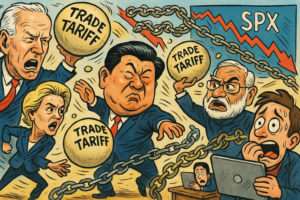
How Not to Trade Like It’s 1930
Hint: Pulse Bars Beat Panic. Every. Single. Time.
Let’s rewind to 1930 one more time…
Back then, traders didn’t have algorithms.
They didn’t have options.
They didn’t even have charts as we know them.
What they had was ticker tape, tea leaves, and tears.
In 2025, you’ve got something they didn’t: a system.
More specifically, a rule-based SPX trading strategy that laughs in the face of macro chaos.
It doesn’t rely on gut feel, guru tips, or the mood swings of trade ministers.
It relies on pulse bars.
What’s a Pulse Bar?
It’s a candlestick closing in the top or bottom 5% of its range.
That’s it.
-
Top 5% close? Bullish.
-
Bottom 5% close? Bearish.
-
Everything else? Ignore it.
This one rule lets you slice through the noise and place a smart, tight credit spread in minutes.
(And it works even when Jerome Powell and Xi Jinping are throwing shoes at each other via press conferences.)
The Trade Flow (Simple as Ever)
-
Scan for a pulse bar in the first 2 hours.
-
Place a credit spread.
-
Walk away.
-
Profit or pass.
-
Repeat.
You don’t need to know what tariffs China just slapped on pork chops.
You don’t need to decode Janet Yellen’s press release at 2am.
You need a signal, a rule, and a rinse-and-repeat method that doesn’t care who’s shouting on CNBC.
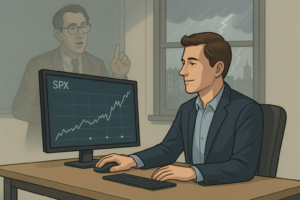
When Everyone Else Panics, We Follow the Checklist
-
No chart-hopping.
-
No market-mood readings.
-
No “hopes and prayers” trades.
-
Just setups based on historical edge.
Over 2,000 trades.
15 years of data.
One pattern.
No drama.
And guess what?
It works whether SPX is flying, falling, or flailing in tariff-induced turmoil.
So, while the rest of the world is dusting off 1930s textbooks,
we’re running the playbook that actually works.
And it doesn’t include panic selling or buying the dip because “maybe it’ll bounce”.
Expert Insights: Common Mistakes in Trade War Environments
Mistake 1: Trading headlines instead of setups
Fix: Use rule-based signals like pulse bars that ignore political noise.
Mistake 2: Overexposing capital trying to “guess” direction
Fix: Stick to defined-risk credit spreads with proper sizing.
Mistake 3: Chart-hopping like a caffeinated squirrel
Fix: One chart. One timeframe. One setup. No zombie trading.
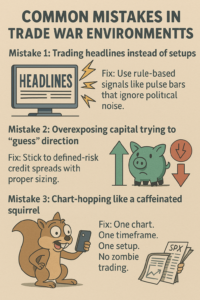
Fun Fact: Ferris Bueller Was (Accidentally) Right About Smoot-Hawley
Remember that droning econ teacher from Ferris Bueller’s Day Off?
“Did it work? Anyone? Anyone?”
He was referencing the Smoot-Hawley Tariff Act of 1930, which raised U.S. tariffs on 20,000+ imports.
It didn’t work.
World trade collapsed by 66% within 3 years.
U.S. exports dropped 61%.
Over 9,000 banks failed.
And unemployment hit 25%.
It was the economic equivalent of trying to put out a fire with petrol and a blindfold.
So when your mate on Reddit says “tariffs make us strong again,” just remember:
Ferris Bueller’s economics teacher predicted this entire mess… and nobody listened.
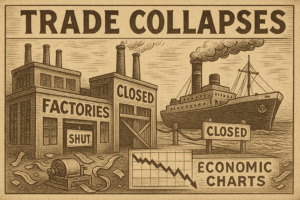
Want a Smarter Way to Trade the Madness?
Tariffs rise. Markets fall. Pundits waffle.
But traders with a plan?
They just keep placing mechanical trades, collecting income cheques, and laughing at the drama from their screens.
If you’re tired of overthinking, doomscrolling, and trading like it’s 1930…
You’ve got two choices:
-
Keep reacting to chaos.
-
Or trade the only setup designed to thrive in it.
The SPX Income System was built for this moment.
One chart. One setup. Zero guesswork.
And you can learn it in the time it takes Congress to argue over what a tariff actually is.
There are 3 ways I can help you…
- Option 1: The SPX Income System Book (Just $12)
A complete guide to the system.
Written to be clear, concise, and immediately actionable.
>> Get the Book Here
- Option 2: Full Course + Software Access – 50% Off
Includes the video walkthroughs, tools for TradeStation & TradingView, and everything I use daily. Plus 7 additional strategies
>> Get DIY Training & Software
Join today and I will personally hop on a quick start call with you to get setup and running in my system in less than 45-mins.
- Options 3: Join the Fast Forward Mentorship – 50% Off
>> Join the Fast Forward Mentorship – trade live, twice a week, with me and the crew. PLUS Monthly on-demand 1-2-1’s
No fluff. Just profits, pulse bars, and patterns that actually work.
